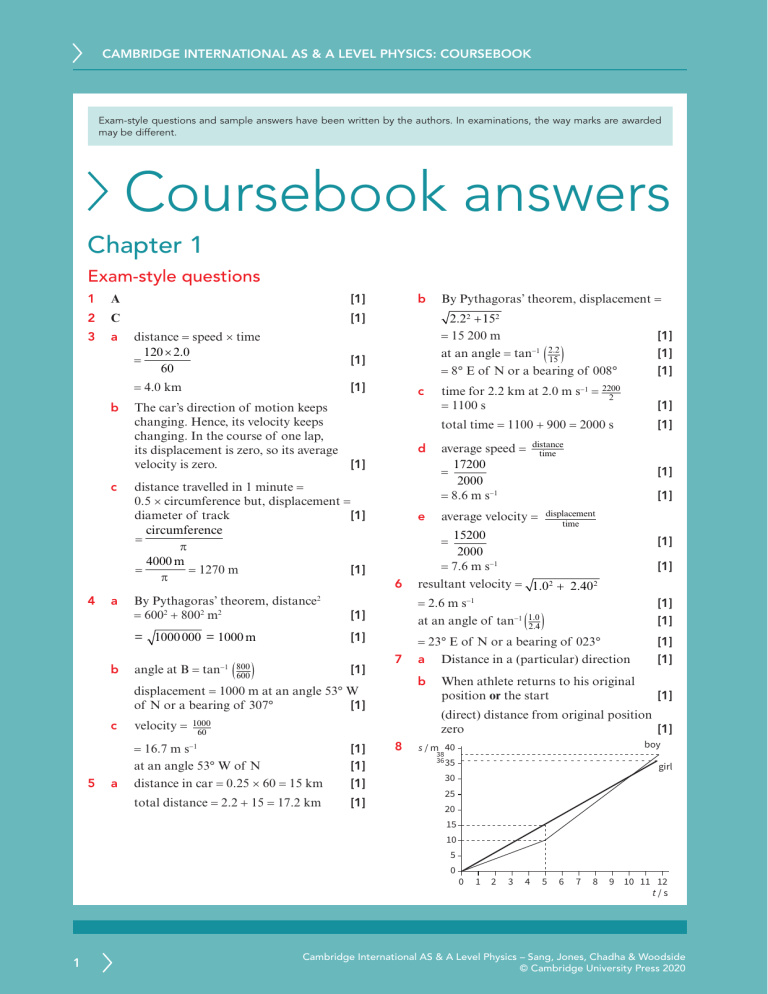
CAMBRIDGE INTERNATIONAL AS & A LEVEL PHYSICS: COURSEBOOK Exam-style questions and sample answers have been written by the authors. In examinations, the way marks are awarded may be different. Coursebook answers Chapter 1 Exam-style questions By Pythagoras’ theorem, displacement = 1 A[1] b 2 C[1] 3 a 2.22 + 152 = 15 200 m[1] at an angle = tan−1 215.2 [1] = 8° E of N or a bearing of 008°[1] distance = speed × time 120 × 2.0 = 60 ( ) [1] = 4.0 km[1] b c 4 c he car’s direction of motion keeps T changing. Hence, its velocity keeps changing. In the course of one lap, its displacement is zero, so its average velocity is zero.[1] istance travelled in 1 minute = d 0.5 × circumference but, displacement = diameter of track[1] circumference = π 4000 m = = 1270 m[1] π total time = 1100 + 900 = 2000 s[1] 6 a By Pythagoras’ theorem, distance = 6002 + 8002 m2[1] [1] ( 800 600 ) 5 velocity = 7 total distance = 2.2 + 15 = 17.2 km[1] average velocity = displacement time 15200 [1] 2000 = 7.6 m s−1[1] resultant velocity = 1.02 + 2.402 = 23° E of N or a bearing of 023°[1] a Distance in a (particular) direction[1] b hen athlete returns to his original W position or the start[1] (direct) distance from original position zero[1] 1000 60 = 16.7 m s−1[1] at an angle 53° W of N[1] a distance in car = 0.25 × 60 = 15 km[1] e ( ) displacement = 1000 m at an angle 53° W of N or a bearing of 307°[1] c average speed = distance time 17200 = [1] 2000 = 8.6 m s−1[1] = 2.6 m s−1[1] at an angle of tan−1 12..04 [1] = 1000 000 = 1000 m [1] angle at B = tan−1 d = 2 b t ime for 2.2 km at 2.0 m s−1 = 2200 2 = 1100 s[1] 8 boy s / m 40 38 36 35 girl 30 25 20 15 10 5 0 1 0 1 2 3 4 5 6 7 8 9 10 11 12 t/s Cambridge International AS & A Level Physics – Sang, Jones, Chadha & Woodside © Cambridge University Press 2020 CAMBRIDGE INTERNATIONAL AS & A LEVEL PHYSICS: COURSEBOOK a Straight line from t = 0, s = 0 to t = 12, s = 36[1] b 100 km h–1 traight line from t = 0, s = 0 to t = 5, S s = 10[1] N Straight line from t = 5, s = 10 to t = 12, s = 38[1] c 9 resultant 500 km h–1 10 s where the graphs cross[1] a Each second, it travels a constant distance.[1] At least two examples: 108 − 84 = 24, 84 − 60 = 24, 60 − 36 = 24 cm[1] b d Correct vectors drawn and labelled[1] 108 + 2 × 24[1] Scale stated and diagram of sufficient size[1] Resultant velocity 510 (±10) km h−1[1] 11° W of N or a bearing of 349° (±3°)[1] = 156 cm[1] c distance = 240 × 0.001 = 0.24 cm[1] 11 a 24 speed = distance = 0.1 [1] time = 240 cm s−1[1] c b The smallest scale division on the ruler is 2 cm and so each dot is blurred by about 1/10th of a scale division. This might just be observable but difficult to see[1] 10 a Vector quantities have direction, and scalar quantities do not.[1] One example of a vector, e.g., velocity, acceleration, displacement, force[1] One example of a vector, e.g., speed, time, mass, pressure[1] 0.25 × 510 = 128 ≈ 130 km 11° W of N[1] velocity of aircr B 7.5 m s–1 15 m s–1 A Correct vector diagram[1] Velocity of aircraft in still air in easterly direction or calculation[1] b t = 5000 15 = 333 s and 5000 13.5 = 370 s[1] total time = 703 or 704 s or 703.7 s[1] average speed = 2 10000 703.7 = 14.2 m s−1[1] Cambridge International AS & A Level Physics – Sang, Jones, Chadha & Woodside © Cambridge University Press 2020